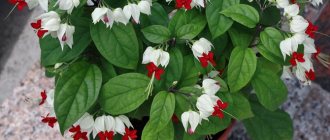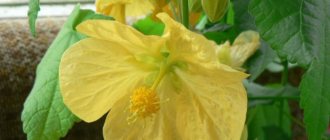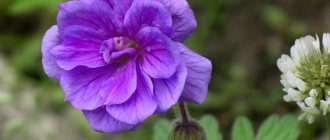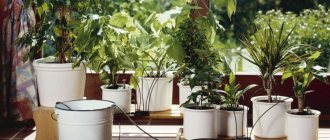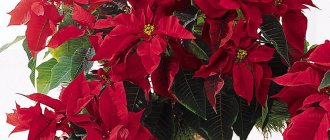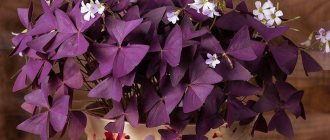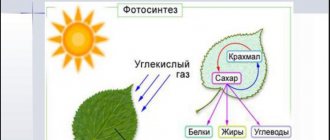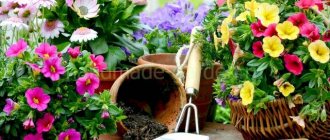What are home grown white flowers with a red center called?
A houseplant with white and red flowers is called clerodendrum. The complex name of this plant translates as “tree of fate.” There is a Javanese legend associated with it that clerodendrum brings happiness. A distinctive feature of these plants are their unusual flowers that take the shape of a butterfly.
Clerodendrum Thomson
Thomson's clerodendrum is a woody vine with fast-growing shoots. This plant is a rare guest in Russian apartments. The most common variety was Prospero. It is distinguished not only by its flowers, but also by its leaves, which look like thick branches. The aroma of blooming clerodendrum has jasmine notes - for this feature the vine was nicknamed “nodding jasmine” by the Japanese.
Description
Clerodendrum blooms in the summer season. The first flowers appear in June, and in September the plant begins to prepare for hibernation. But if we consider the Fragrant Clerodendrum, it is capable of blooming all year round with proper care. The aroma of the plant comes not only from the buds, but also from the leaves. The smell may vary depending on the variety.
The leaves of the vine reach a length of 20–30 centimeters. The shoots of the plant quickly become woody during the period of active growth.
Flower growers note the following features of clerodendrum:
- The shape of the bush is adjusted by pinching and pruning. The plant can be bush-like, ampelous or standard.
- The flower surprises with its unpretentiousness and endurance. During the dormant period, it does not freeze even at a temperature of twelve degrees.
- As the bush matures, it needs to be replanted less frequently. A young plant changes pots once a year. Mature - once every 3-4 years.
Care
During the growing season, clerodendrum needs periodic watering. It is necessary to spray the plant with a spray bottle in the evening. The bushes tolerate soft, settled water well. The frequency of watering is determined by temperature conditions. On hot summer days, the vine needs frequent watering. At other times, hydration is reduced. To determine a flower’s need for moisture, just look at the soil.
Important. In order for the flower to be preserved over the winter, it must be protected from all heating devices. Despite hibernation, clerodendrum may suffer from excessive dry air. Overdrying the earthen clod will result in the death of the plant.
Flower growers begin to fertilize clerodendrum in the second half of April. To saturate the plant with microelements, two feedings per month are enough. Complex fertilizer for flowering indoor plants is used as fertilizing. During the hibernation months, the bush does not need fertilizers.
Clerodendrum requires periodic pruning to adjust growth. Two types of pruning are applied to the plant:
- Rejuvenating. During rejuvenation, weak and dried shoots are removed. Healthy stems are shortened by a third to stimulate growth. If you follow the pruning rules, the bushes will produce young, fast-growing shoots. Inflorescences will begin to actively form on these shoots.
- Formative. A dense crown is the key to the health and beauty of the plant. If a gardener wants to turn clerodendrum into a bush, in the spring he will need to greatly shorten the stems. To give a flower a stem shape, it must be removed from all shoots except one - the strongest. To form the crown, all upper stems are pinched.
Clerodendrum needs frequent soil renewal. It quickly absorbs all nutrients and depletes the substrate. Another reason for replanting is that the pot is cramped: if there is not enough space, the plant will wither. The transplant should coincide with the beginning of the growing season. If the grower plans to prune the bush, this task must be completed before replanting.
The bush is suitable for fertile soils with a slightly acidic reaction. You can buy the substrate at the store or prepare it yourself.
The following components will be needed for the soil mixture:
- coarse sand;
- peat;
- clay and leafy soil.
Important. Before planting clerodendrum, the substrate must be disinfected. For these purposes, gardeners use ovens, ovens or microwaves.
When transplanting, the exact sequence of actions must be followed:
- A drainage layer 3 centimeters high is poured onto the bottom of the pot.
- The flower is lowered into the pot using the transfer method. During transplantation, you need to try not to damage the earthen ball.
- The voids in the pot are filled with prepared substrate.
- After compacting the earth, the bush is watered.
If the plant requires support, it is installed during transplantation. If you stick a stick into the soil mixture later, there is a risk of damaging the root system.
Basic requirements of Guzmania - light, temperature, humidity
Even such an unpretentious home flower as Guzmania requires compliance with certain conditions.
Many amateur aquarists breed angelfish at home; it is not difficult. How many people know what this name of popular aquarium fish means?
Look right now how beautiful and unusual the ordinary garden lilac is!
So, it is placed on western or eastern windows, in partial shade . Guzmania can only be moved to the south side in winter - this compensates for the natural lack of light.
As for the temperature , even novice gardeners will not have problems here: in summer 20-25 degrees is enough, and in winter - no lower than 17. If the temperature drops to 16 degrees, the plant may get sick or not want to bloom.
The Morente look seems to imitate the colors of autumn.
to humidity , because it comes from the tropics. In summer, take it out onto the loggia, and in winter, a lighted bathroom may be a suitable place. You can place a humidifier or indoor fountain nearby. Regularly add water to the pan, but do not let it stagnate. Guzmania will also like spraying - and in the heat, “showers” can be carried out 2 times a day.
Lemon guzmania with bright yellow bracts.
Flowers with large leaves
Flowers that differ in the size of their leaves include:
- Anthurium. The leaves of this plant reach a length of 30 centimeters. Flowers with a yellow erect inflorescence and a bright red petal that resembles a sail. Anthuriums are light-loving flowers that do not get along with drafts and coolness.
- Spurge. Euphorbia leaves are dark green in color. Their length ranges from 10 to 15 centimeters. The deep red petals are shaped like the pointed leaves. This plant blooms during the winter months.
- Vallota. Wallot leaves are pointed and sword-shaped. They can reach half a meter in length. They come in a dark green shade, which turns into dark red towards the base. With proper care, the plant blooms twice a year.
- Clerodendrum. The leaves of the plant grow up to 30–35 centimeters and have the shape of a vine. The plant itself has become famous due to the unusual color of its flowers, which combines red and white.
Methods for propagating clerodendrum
Reproduction is carried out in two ways: seeds and rooting cuttings.
Propagation by seeds
- Seeds should be sown in spring in loose and nutritious soil.
- Then the container with the plantings is covered with glass and placed in a bright and warm place.
Maintenance consists of daily ventilation of the greenhouse and keeping the soil moist. Shoots appear in 1.5 - 2 months.
Propagation by cuttings
For cuttings, you can take shoots left after spring pruning.
- They are divided into segments with at least two internodes.
- It is advisable to treat the sections with root formation stimulants.
Rooting can be done in water or a moist and loose substrate.
Poinsettia in spring
With the onset of warm spring days, poinsettia ends its flowering. The bracts are falling and the leaves are starting to fall. This means that the plant is entering a dormant phase.
Trim the Christmas star flower. It is better to leave shoots only 7-10 centimeters high in the pots. Place it in a shaded area. It is desirable that during the resting phase the air temperature in the room should be within 12-15˚C.
Water infrequently. It is necessary to allow the earthen coma to dry out completely between waterings.
Such conditions for caring for poinsettia flowers must be observed for one and a half to two months.
Diseases and pests
Leaves and inflorescences may begin to lose color, fade, and fall off. This means that you have over-moistened the soil, or placed the pot with the plant in a draft, or the plant does not have enough lighting.
If the leaves turn brown and the flowers fall off, the flower is too hot and dry.
Most often, poinsettia suffers from attacks by thrips, spider mites and mealybugs.
If there are wavy oblong spots on the leaves, or the leaves begin to curl, then these are thrips.
The scale insects cause the leaves to become covered with honeydew (a sticky, drop-like secretion).
If the leaves begin to rapidly turn yellow and dry out, this is a spider mite.
Wipe the plant with soapy water and rinse under a warm shower (but do not over-wet the soil). Treat with pest repellents.
Caring for Guzmania at home
The homeland of this exotic plant for us is Central and South America. In those parts it grows as an epiphyte, that is, it begins to develop its root system not on the ground, but on the bark of trees, usually dying. And it receives water from moist air.
Currently, more than one hundred species of this plant are known. In indoor conditions, they most often contain guzmania reed and the minor rondo variety. They are quite unpretentious, and in appearance they are not inferior to their brothers.
Externally, guzmania is a large evergreen bunch of long grassy leaves, a bright, beautiful pre-bloom and flower. In wild conditions, the height of the plant reaches 75 cm, but in houses it rarely grows above 40 cm - this is due to lack of humidity, limited root system and little sunlight. The flowers typically come in bright red, burgundy, brownish and pink hues, creating a contrast with the green leaves.
And although at first it seems that guzmania is a whimsical, capricious plant that is uncomfortable in our climatic conditions, in fact this is a myth. As practice shows, it does not require much time and effort from the owner; it is enough to just follow a few simple conditions.
How to properly water Guzmania
Since guzmania is a bromeliad plant, water it in the following way:
- Water in moderation is poured into the outlet, and the residues that are not absorbed in the first minutes are drained;
- The soil can be watered only in dry weather and high air temperatures. An alternative to this is to leave some water in the tray;
- Watering is carried out every day or every other day in the summer, and in winter it can be limited to 1-2 times a week;
- Guzmania does not tolerate excessive watering; it is better to dry out the soil a little rather than let the water stagnate in the outlet for a long time;
- The plant should be sprayed daily with clean water from a spray bottle;
- For irrigation, slightly warm soft water is used, which has stood for at least 2 days;
- Sometimes the guzmania plant can be wiped down with a damp sponge to remove dust and pests.
Light level
Ideally, the guzmania pot should be kept in partial shade in a room that faces west or east. In winter, it can be placed on the south side to compensate for the lack of sunlight. No need to place the plant directly on the windowsill!
Firstly, in winter it will suffer from drying out, since the heating system will be located directly under it. Secondly, direct sunlight can cause burns, which is usually expressed by partial drying of the leaves and brown spots on them. This is also evidenced by dry, curling ends.
Required temperature
In principle, ensuring a comfortable temperature regime for guzmania is not difficult. It is enough to keep the air temperature at 20-25 degrees in summer, and 17-20 degrees in winter. But you shouldn’t let it drop below 16 degrees - guzmania may not die if it gets caught in a draft and freezes, but this can cause diseases or problems with flowering.
Air humidity
Guzmania loves moist air, which is not surprising - it partially absorbs water from the environment, not only from the soil. The most optimal level would be 60-85%. This means that the plant will feel great in the summer in the loggia or in the kitchen, and in winter it can be placed in the bathroom if there is a window there. Otherwise, a humidifier or indoor fountain will help you solve the problem of dry air. Do not forget that you can add water to the pan, but you cannot overdo it, otherwise the root system will begin to rot from below.
Varieties and varieties
Variegated
Sonora Marble
Sonora Marble
A creamy beauty with an ivory hue interspersed with a pink tint in the middle.
Winter Blush Marble
Winter Blush Marble
Surprising with the non-standard color scheme of the leaves. The crown has a soft pink color with a milky edging, surrounded by grass-colored leaves.
Strawberry and cream
Strawberry and cream
Unrealistically beautiful “marble” look. An interweaving of soft white spots with a coral tint of foliage.
Da Vinci
Da Vinci
An amazing view, striking in its beauty. Non-standard color scheme in the style of “pink flamingo”.
Monet Twilight
Monet Twilight
The owner of cream flowers with a blurred pink tint, as if stained with scarlet paint.
Tapestry
Tapestry
A chic variety, the characteristic feature of which is the heart-shaped leaves of a deep scarlet color.
Yellow and orange representatives
Lemon snow
Lemon snow
The owner of a pale lemon color.
Cinnamon star
Cinnamon star
Representatives of this variety have tiered leaf color. An amazing combination of orange color, smoothly turning into rich yellow, which turns into leaves with green veins. A distinctive feature of this species is its sharp, jagged leaves.
Orange Poincettias
Orange Poincettias
The elongated leaves of this variety have a rich orange color.
Yellow Poincettias
Yellow Poincettias
Representatives of this species have all shades of pistachio color.
Euphorbia pulcherrima
Euphorbia pulcherrima
The owner of a fiery hue. The color scheme of the leaves smoothly transitions from rich yellow to fiery orange.
Holders of white leaves
White Star
White Star
The name itself speaks for itself! Elongated, pointed leaves of pearl-beige color, collected in a bouquet, look like huge stars!
Polar Bear
Polar Bear
Representatives of this species resemble a piece of iceberg in their color. The core of the flower has a yellow tint with a slight green tint.
Arctic White
Arctic White
Cool white flowers against the backdrop of rich green leaves will not leave anyone indifferent.
All shades of red
Tapestry
Tapestry
An amazing variety that fascinates with its beauty. The flowers are a rich fiery scarlet color, and the leaves that grow along the shoot are two-colored, with a yellow coating on the edges.
Carousel Red
Carousel Red
A very unusual variety! A distinctive feature of which is the openwork edges of the inflorescence of a rich red color, which distinguishes it from the leaves themselves.
Carousel Dark Red
Carousel Dark Red
Very similar to the previous species, especially in the structure and shape of the flower, only the shade is dark scarlet.
Premium Red
Premium Red
This is a classic among all varieties. It is a lush bright red inflorescence in the middle of the crown. The core is standard - yellowish-green.
Cortez Burgundy
Cortez Burgundy
A representative of a rich burgundy shade with a traditional heart-shaped petal shape.
Other varieties
Blue poinsettia
Blue poinsettia
This view has mesmerizing beauty! The flowers are electric blue and are combined with rich green leaves, which are painted with uneven dark veins.
Eckespoint Lilo
Eckespoint Lilo
A very non-standard color scheme for poinsettias. Purple flowers with a lilac sheen.
Polly Pink
Polly Pink
The brightest representative of pink! The leaves are deep pink.
Prestige Maroon
Prestige Maroon
Queen among poinsettias! A rich, noble burgundy wine shade combined with dark emerald leaves gives this variety a regal appearance.
Brief description of cultivation
- Bloom . Each Guzmania rosette blooms only once, after which it dies.
- Illumination . The light should be bright and diffused.
- Temperature regime . The air temperature should not be higher than 27 degrees and lower than 13 degrees. This flower grows best at a temperature of 25 degrees during active growth and development, and at 20 degrees during the flowering period.
- Watering . It is carried out immediately after the top layer of soil mixture in the pot has dried a little.
- Air humidity . It should be elevated. To do this, the bush is moistened every day from a sprayer with well-settled lukewarm water.
- Fertilizer . Fertilizing is carried out from March to September once every 4 weeks; for this purpose, fertilizer for bromiliaceae is used, and the concentration of the nutrient solution should be 2 times less than what is written in the instructions.
- Transplant . This flower does not need to be replanted.
- Reproduction . In rare cases, by seeds, and most often by lateral shoots.
- Harmful insects . Scale insects, mealybugs and spider mites.
- Diseases . Root and gray rot.
Feng Shui
Poinsettia in the interior
Bright red poinsettia activates fiery energy and speeds up all processes. It can be kept in your personal account to generate new ideas, increase income, and improve communication skills. In the marital bedroom, she will add passion to intimate relationships. In the kitchen or dining room, a flower will bring special benefits: it will make family feasts fun and enjoyable, attract prosperity, improve the taste and energy of food, increase metabolism in the body and help lose weight.
Feng Shui masters say that the living room is a universal place for poinsettias. Here it performs the main functions: creates a favorable atmosphere, establishes mutual understanding between family members, and produces the energy of joy.
If there is already too much “fire” in your house (bustle, guests, excitement, rush, constantly changing events, etc.) - opt for a decorative variety with a different shade of bracts: pink, peach, creamy yellow, orange.
If you strive for spiritual growth, get a purple variety, and if you want clarity of thinking and serenity, get a blue one.
Poinsettia: signs and superstitions
Blooming luxuriantly at Christmas, poinsettia has healing powers and brings good luck. It should be placed in the center of the Christmas table - then those present will be healthy, joyful and rich all year long.
Natural poinsettia has bright red bracts - it attracts well-being, prosperity, good mood and pleasant guests to the house, and helps children study better. Today, breeders are developing varieties of a wide variety of colors and shades. The palette also affects the energy: soft pink, peach and creamy yellow varieties have less pronounced fire energy, and blue and purple varieties have an element of the water element.
Poinsettia Sonora White glitter
Other beliefs:
- If a cat gets into the habit of eating this flower, it is in the wrong place. Judging by the sign, another part of the house needs his positive influence - rearrange the flowerpot until the animal loses interest in it. But at the same time, follow the rules of maintenance - plenty of light and no drafts.
- Leaves on the plant suddenly fall off - this means that one of the family members is ill. This is often due to lack of care - eliminate mistakes and take care of the flower correctly. While recovering, he will restore favorable energy. However, if abscission occurs naturally (after flowering on the eve of the dormant period), this superstition is not relevant.
- If, during pruning, milky juice splashes directly into the face, the omen speaks of a dangerous ill-wisher. He spreads bad rumors, weaves intrigues and tries to harm you. Use cut cuttings to propagate the plant - this way you will strengthen protection and improve the quality of life, despite the machinations of enemies.
- A gift of poinsettia strengthens relationships between people, making them joyful, selfless, loving and faithful.
Is poinsettia poisonous or not?
Poinsettia tissue contains poisonous white milky juice - as does all other members of the family. This juice contains euphorbic acid, euphorbine and cyanogenic compounds, which can painfully burn the skin, cause inflammation, and if it gets into the eyes, even temporarily blind a person.
Poisonous juices are found in the roots, leaves and stems.
It is also worth knowing that the flowering leaves that delight us (those that are so beautifully colored red) owe their color to dyes belonging to anthocyanins.
Poinsettia
All this sounds menacing. And so much so that some believe that the name of the plant comes from the English. the word poison, meaning "poison". But this is just complete nonsense! The name "poinsettia" comes from the Poinsett surname of a man named Joel Roberts, who brought the Star of Bethlehem from Mexico to the United States.
In practice, as it turns out, information about the strong toxic effect and toxicity of poinsettia is greatly exaggerated.
Although Star of Bethlehem may cause gastrointestinal distress, nausea, and vomiting after ingestion, in practice this occurs in less than 10% of human consumption of the plant. The discomfort is usually very mild and rare.
However, if a poinsettia flower appears in the house, it should be installed in a place inaccessible to small children, and when caring for the plant, avoid direct contact with juices that may leak, for example, when a branch is broken. But there is no need to exaggerate. A huge number of indoor plants grown in our apartments can be much more poisonous than the Star of Bethlehem.
Do I need to move it to another pot after purchase?
There is no need to go through this procedure after purchase. But if you see that the plant is cramped in its previous pot, immediately transplant it into a new one. In places of sale, flowers are often planted in small pots to save space, so the soil is quickly depleted, and the roots lack not only space, but also nutrition.
Another important point is that in the store indoor flowers are sold in pots with transport soil. It is very light, making plants easy to transport. However, flowers do not feel very comfortable in it. This is another reason why purchased flowers need to be replanted.
POINSETTIA CARE.
Poinsettia does not tolerate cold, so do not buy this flower outside during the frosty season. When purchasing, pay attention not so much to the bracts, but to the flowers themselves - they should be in buds, and not fully open (this means that the poinsettia has been blooming in the store for quite a long time, and we want it to bloom in our store for as long as possible Houses).
After you bring the flower home, the poinsettia indoor plant requires attention and care for long-term flowering. The temperature during flowering should not fall below + 16 degrees, but too warm dry conditions have a bad effect on this flower. Poinsettia does not tolerate drafts and sudden changes in temperature. In this case, the flower may shed its leaves.
A flowering plant requires the brightest lighting that can be provided in an apartment. Falling leaves can also be a response to lack of lighting.
During this period, the poinsettia should be watered abundantly, but only when the soil in the pot dries out. Do not allow water to stagnate in the pan. It is highly advisable to spray the leaves with warm, settled water.
Stages of flower transplantation
- Pick up a new pot. It should be 2-3 cm larger in diameter than the previous one. There is no need to take containers that are too large - water stagnates in them, which often leads to rotting of the roots.
- Select the soil mixture based on the plant variety.
- Water the plant a day before you plan to transplant it. If you can’t do it in a day, do it at least an hour in advance.
- Make a drainage layer at the bottom of the pot. You can use broken bricks or shards. Place a layer of expanded clay on top. Add sand and a 1-2 cm layer of fresh soil.
- Take the flower pot in your hands, turn it over and lightly tap it on the table, gently holding the plant. If this is problematic, separate the roots from the walls using a sharp knife.
- If there are old shards at the bottom, remove them. Leave some of the soil on the roots so as not to damage them. If some roots are rotten or damaged, cut them off.
- Place the flower on a layer of soil in a new pot, carefully fill the remaining space with fresh soil. To ensure that there are no voids left, after adding another layer of soil, tap the edge of the pot on the table. The stem should be located in the middle.
- Press the soil around the roots with your fingers. Water the plants generously and move them to a sheltered place for a couple of weeks. Spray the leaves every day. After the specified time, the flower can be placed in its original place and cared for as usual.
